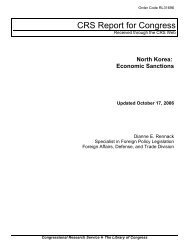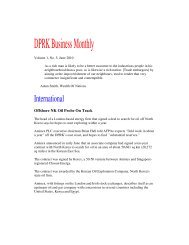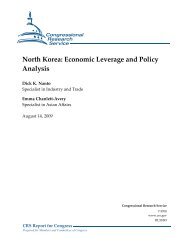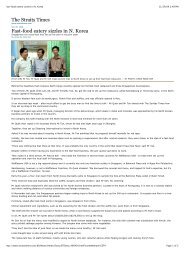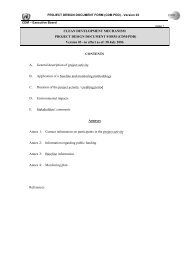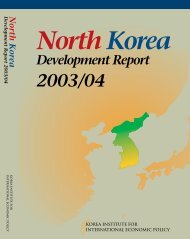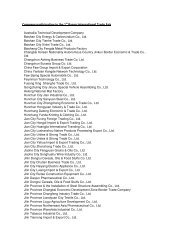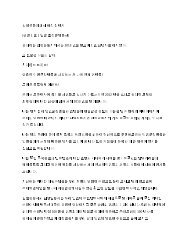North Korean Policy Elites - Defense Technical Information Center
North Korean Policy Elites - Defense Technical Information Center
North Korean Policy Elites - Defense Technical Information Center
You also want an ePaper? Increase the reach of your titles
YUMPU automatically turns print PDFs into web optimized ePapers that Google loves.
Table II-6. Kim Chong-il’s Principal Supporters<br />
Name<br />
First Echelon Supporters 21<br />
Kim Yong-nam<br />
Kye Ung-tae<br />
Chon Pyong-ho<br />
Han Song-yong<br />
Kim Kyong-hui<br />
Kim Yong-woo<br />
VM Kim Yong-chun<br />
Politburo Member<br />
Politburo Member<br />
Politburo Member<br />
Politburo Member<br />
Position<br />
Director, KWP Light Industry Department<br />
Chairman, Economic Cooperation Committee<br />
Chief of General Staff<br />
V. Mar. Cho Myong-nok Director, General Political Bureau<br />
Gen. Won Ung-hui<br />
Mar. Yi Ul-sol<br />
Second Echelon Supporters<br />
Chang Song-taek<br />
Yi Yong-chol<br />
Yom Ki-sum<br />
Yi Chi-kang<br />
Mun Myong-on<br />
Yim Tong-ok<br />
Chu Kyu-chang<br />
Kang Sok-chu<br />
Gen. Yi Myong-su<br />
Gen. Pak Chae-kyong<br />
Gen. Hyon Chol-hae<br />
VM Chang Song-u<br />
Yi Nun-sil<br />
Lt. Gen. Chang Song-kil<br />
Commander, Security Command<br />
Commander, Guard Command<br />
1st Vice Director, OGD<br />
1st Vice Director, OGD (Military Affairs), Member, KWP CMC<br />
1st Vice Director, OGD<br />
1st Vice Director, OGD<br />
1st Vice Director, OGD<br />
1st Vice Director, Reunification Department<br />
1st Vice Director, Munitions Department<br />
1 st Vice Minister of Foreign Affairs<br />
Director, General Staff Operations Bureau<br />
Deputy Director, GPB Propaganda Bureau<br />
Deputy Director, GPB Organization Bureau (oversees military<br />
personnel affairs)<br />
Commander, Third Corps<br />
Vice Commander, Guard Bureau<br />
Political Committee Member, 820 th Tank Corps. Reported<br />
links to KPA intelligence.<br />
As in all totalitarian regimes, power can be understood as a series of concentric circles<br />
surrounding the pre-eminent leader. 22 The above discussion referenced the outer circles of power.<br />
The innermost circle includes those in closest proximity to Kim Chong-il: members of his<br />
21 In this chart, “echelon” refers to the formal position of the person in the apparatus. Those in the first echelon are<br />
either in decision-making positions or control specific bureaucracies. Those in the second echelon are key players<br />
within specific institutions.<br />
22 The concept of concentric circles as a way of understanding totalitarian regimes is not new, but was developed in<br />
the 1930s as a way of explaining the Nazi and Stalinist regimes. The concentric circles refer to the tiers within the<br />
leadership based on access to the pre-eminent leader. Those within the inner circle enjoy the greatest access, trust,<br />
and access to information. Those in the second tier are normally associated with security functions and portfolios.<br />
Those in the third tier are also associated with security functions, but not necessarily part of the Praetorian Guard.<br />
Family relationships and patronage systems cut across all the circles.<br />
II-19



